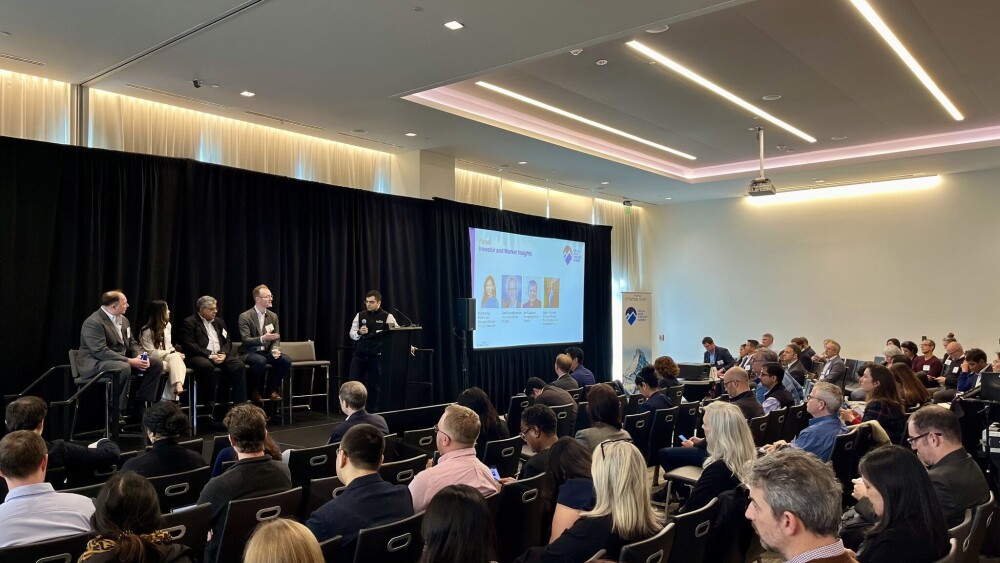QurAlis has taken a biomarker-driven approach to treating ALS all the way to another bank deposit, closing an oversubscribed $88 million Series B round Thursday.
Pictured: A women sits at a computer in front of a city landscape/Courtesy of Getty Images
QurAlis has taken a biomarker-driven approach to treating ALS all the way to another bank deposit, closing an oversubscribed $88 million Series B round Thursday.
Along with the financing, the Cambridge, Mass.-based biotech announced the appointment of two new board members: Cillian King, Ph.D., managing director at EQT Life Sciences, and Laia Crespo, Ph.D., partner at Sanofi Ventures. EQT led the round, which brought QurAlis’ total funds to $143.5 million.
The company closed a $42 million Series A in May 2020.
“[QurAlis has] a very strong focus on genetically validated targets and a very biomarker-driven development strategy, and this is exactly how we feel precision medicines should be developed for neurodegenerative diseases like ALS,” King told BioSpace prior to the announcement.
QurAlis’s target is a protein called stathmin-2. Encoded by the STMN2 gene, stathmin-2 is well-known for neural repair and axonal stability that is downregulated in nearly all people with ALS.
The company will dedicate the new funds to advancing its two clinical-stage programs.
QRL-201 is being developed to rescue STMN2 loss of function in patients who also have TDP-43 pathology – an established disease driver in 97% of ALS patients.
In ALS, a cryptic exon in the pre-mRNA of STMN2 is exposed, leading to a stop in transcription and resulting in a loss of the STMN2 protein causing neurodegeneration.
“QRL-201 is a splice switching ASO that binds to the pre-mRNA restoring the STMN2 protein which protects motor neurons against neurodegeneration,” Kasper Roet, Ph.D., founder and CEO of QurAlis, told BioSpace.
Health Canada authorized QurAlis’ clinical trial application for this asset in December 2022. Roet said the trial will assess safety, tolerability and proof of concept and will take about two-and-a-half years.
QurAlis intends to expand the study across multiple geographical locations, including the U.S., U.K. and Europe.
The company’s other clinical-stage asset is QRL-101, a selective Kv7.2/7.3 ion channel opener intended to reduce hyperexcitability-induced motor neuron degeneration in ALS. It is being assessed in a safety and tolerability study of healthy volunteers.
QurAlis kicked off the Phase I study in January 2023, and Roet said the company intends to conclude this phase in Q3 and move into patients in the fourth quarter.
“Both of these targets are precision medicine targets,” Roet said. “Both are genetically regulated through missplicing in large cohorts of sporadic ALS patients, and both…will carry both target engagement mechanism of action and efficacy biomarkers combined with functional readouts.”
King is particularly excited about QurAlis’ FlexASO platform, which he said is “quite unique and differentiated from what’s out there already.”
In addition to the pharmacological kinetics, King highlighted the biodistribution aspect of the platform. Even beyond ALS and motor neuron disease, “Penetrating deep brain tissues with [ASOs] opens up a whole new field of neurodegenerative diseases that could be treated,” he said.
King said he sees QurAlis as a platform company, particularly highlighting FlexASO.
Biomarkers Gain Traction
QurAlis’ approach appears to align with the FDA’s evolving view on neurodegenerative diseases.
With the approval of Eisai and Biogen’s Leqembi (lecanemab), the FDA signaled its willingness to approve drugs for Alzheimer’s disease based on their effect on amyloid beta plaques.
“I think it’s a great move and I hope the field is moving in this direction,” King said.
While the FDA isn’t quite there yet with ALS, Roet highlighted the upcoming advisory committee meeting for Biogen and Ionis’s tofersen for superoxide dismutase 1 (SOD1) ALS.
Here, neurofilament light chain (NfL) will face a key test as a surrogate biomarker reasonably likely to predict clinical benefit. The FDA’s Peripheral and Central Nervous System Drugs advisory committee will meet on March 22.
“QurAlis is all about biomarkers,” Roet said. “We think that is needed to accelerate drug development, and we’re excited to see that move to a more mature space in ALS, and hopefully soon.”








